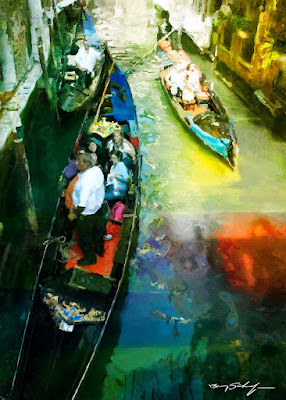 The concept of image creation often takes many directions that lead the artist into individual choices. We often hear that because of this flexibility there are no rules to the process. We are told to forget all the rules of design and go with the flow of our feelings and just create. But I wonder, how can you forget what you never knew? I think that one must learn the rules first in order to forget them. To make them intuitive to the creative process so they become subconscious to the artist. In this way we can forget the rules and still make good choices. We can trust our gut feelings knowing that they are founded in deep design principles proven over many generations of image making.
The concept of image creation often takes many directions that lead the artist into individual choices. We often hear that because of this flexibility there are no rules to the process. We are told to forget all the rules of design and go with the flow of our feelings and just create. But I wonder, how can you forget what you never knew? I think that one must learn the rules first in order to forget them. To make them intuitive to the creative process so they become subconscious to the artist. In this way we can forget the rules and still make good choices. We can trust our gut feelings knowing that they are founded in deep design principles proven over many generations of image making.Keeping this in mind lets look at the blank canvas of the creative mind. Lets start by asking some basic questions. Where to begin? What is the content of the vision? What do you want it to communicate? How will we divide the space? These types of questions provide a direction for the artist, they set the stage for the message. Next are the 10 steps that I find helpful.
1. Think about the zones of the image you want to create. By this I mean for-ground, middle-ground and back-ground. Will the image be lit from the back to the front or the other way around?
2. If lit from the back start with the lighter pastel colors, form the large negative distant spaces first. As you move from the distant back to the middle-ground deepen the tones as you form larger closer shapes.
3. Reserve the darkest tones for the for-ground imagery, in this way the image has a visual light orientated logic.
4. Work from general to specific and don't develop detail to quickly... stay loose as you work keep the imagery moving. Flexibility is key. Remain uncommitted to your first choices.
5.Keep in mind placement of shapes to conform to the way the composition is to be viewed. Avoid moving down the middle. Create forms that move left and right as they come closer.
6. Examine the scale relationships so they assume the proper dominance to the overall meaning within the statement.
7. Vary the hue within forms to excite the eye.
8. Keep in mind the light source and consistently be true to it's direction as you shape the content.
9. Turn form with light and shade and accent with highlight and shadow.Reserve details and complexities for last. Always work from the ambiguous to specific.
10. Turn form with light and shade and accent with highlight and shadow.
OK, now you get the idea... do all this while you forget all of it.
Apply this to realism or abstraction it still works. If you master this you will be free to consider the overall meaning of the communication. Why are you making this image? What does the composition mean to you and your audience? Did you fulfill the content and meaning or is the message lost to vague unresolved forms that mislead the meaning? It is at this point that you are your own worst critic, judge and jury. It is now that you must decide the fate of the work. Will it see the light of day and be shared with the world or will it be banished to the reject pile. For me this is the most difficult part of the creative process. In the end even with all this hard work and thoughtful execution it is guaranteed that there will be those that love what you do, others that misunderstand it's meaning and hopefully only a few that do not appreciate the result at all.
1 comment:
Brilliant! Such good advice.
-Paul C
Post a Comment